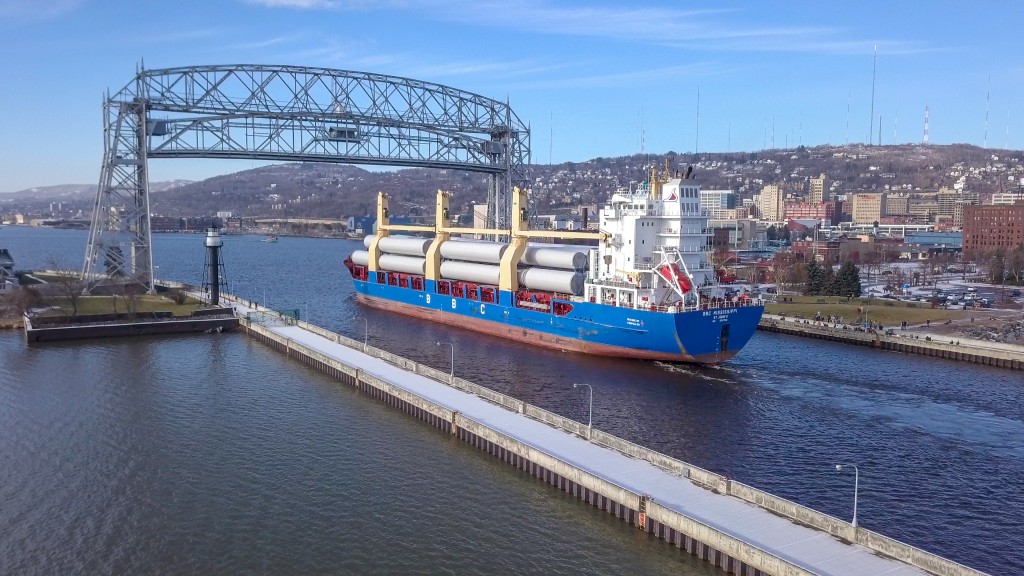U.S. agriculture builds momentum in the Great Lakes-St. Lawrence Seaway System
Amidst a challenging 2020 navigation season, overall tonnage across the Great Lakes-St. Lawrence Seaway System is down 7.9 percent compared to this time last year. From the opening of the St. Lawrence Seaway on April 1, 2020 through October 31, 2020, American and Canadian ports handled a total of 27.6 million metric tons (mt). In October, ports in the Great Lakes-St. Lawrence Seaway System traded with a total of 31 countries across the globe.

Craig H. Middlebrook, Deputy Administrator of the U.S. Saint Lawrence Seaway Development Corporation said, “Shipments of agricultural exports through the St. Lawrence Seaway continue to be robust, as reflected by the October tonnage increases. Outbound grain shipments will likely continue to be strong through the end of the year. This also signals good news for the beginning of the 2021 navigation season next spring, as crop reserves in storage will be ready to load for shipment overseas.”
Shipments of U.S. Agriculture Gain Speed Globally through the St. Lawrence Seaway
Month (2020) |
Metric Tons Handled |
U.S. Grain Growth |
July |
496,000 mt |
27.5 percent decrease* |
August |
713,000 mt |
19.7 percent decrease* |
September |
1,112,000 mt |
4.2 percent increase* |
October |
1,327,000 mt |
10.7% increase* |
*Percentages rounded to nearest tenth (compared year-over-year)
Shipments of U.S. agricultural products, like grain and soybeans, continued to pick up pace as global demand increases. In September, Great Lakes-Seaway System ports closed a 19.7 percent August deficit (compared year-over-year), improving U.S. grain tonnage to a 4.2 percent increase year-over-year. October saw an even higher increase in U.S. agricultural movements, with tonnage 10.7 percent ahead of 2019’s grain performance.
American ports, like the Toledo-Lucas County Port Authority, are attributing the gain in grain tonnage to a stronger 2020 crop compared to last season’s harvest. Ports are hopeful that U.S. agricultural movement will help offset tonnage decreases of other commodities.
“So far in 2020, the negative impact of decreased coal and dry bulk shipments has been mostly offset by increases in aluminum, grain and iron ore,” said Joseph Cappel, VP of Business Development for the Toledo-Lucas County Port Authority.
Through October the Port of Toledo has handled over 7.25 million tons of cargo and nearly 400 vessels have loaded or discharged at the Port. “We are about 3% behind 2019 totals and we are hopeful that robust export programs for soybeans and corn will help us catch up to and possibly surpass 2019 totals by the end of the year. That would be quite an accomplishment given the negative impacts COVID has had on the global economy.”
Top-performing Great Lakes-St. Lawrence Seaway commodities through October 2020
Commodity
Metric Tons Handled |
Growth* | |
Grain** |
8931000 mt |
19.3 percent increase* |
Gypsum |
626000 mt |
37.8 percent increase* |
Steel Slabs |
305000 mt |
90.8 percent increase* |
Asphalt |
298000 mt |
50.8 percent increase* |
Scrap Metal |
64000 mt |
126.4 percent increase* |
*Percentages rounded to nearest tenth (compared year-over-year)
**Combined U.S. and Canadian
Commodity Spotlight: Wind Energy Components Power American Projects
Wind-related shipments at American ports continued to pick up momentum in October as demand for such cargos increases for use on wind farms across the country. Among others, the Port of Indiana-Burns Harbor and the Port of Duluth-Superior handled such commodities during October.
With traditional shipments slowing, wind turbine shipments continue to have a significant positive impact on the Port of Indiana-Burns Harbor’s 2020 shipping season. In October, the port handled three shipments of wind cargos — originating in Mexico and India — via the St. Lawrence Seaway.
“The wind turbine shipments provided much needed manhours for the Longshoremen and Operating Engineers that work on the dock and we were thrilled that Burns Harbor was able to accommodate these challenging pieces without incident,” said Ian Hirt, Port Director for the Port of Indiana.
Similarly, the Port of Duluth-Superior reported increasing wind cargo shipments as the navigation season progresses. This season, the port is positioned to outdo its single-season wind cargo record, which was previously set just last year.
In October, there were ten wind cargo arrivals to Duluth Cargo Connect at the Clure Terminal, carrying wind blades, nacelle components, turbines and towers from India, Malaysia, Turkey, Brazil, Spain, Germany and Mexico.
“The effect of energy-related cargo in the Port of Duluth-Superior this season is significant. We’re anticipating the arrival of 30 vessels carrying more than 500,000 freight tons of wind energy cargoes in 2020, which would easily eclipse the port’s single-season wind cargo record set in 2019. Looking beyond the numbers, this port’s emergence as a wind cargo hub is an important win for cargo diversity and also for the expansion of renewable energy nationwide,” said Deb DeLuca, Executive Director of the Duluth Seaway Port Authority.
Similar Stories

Drewry’s World Container Index - 16 Jan
View ArticleMSC GRI - update scope: Import ISC/ME - Indian Subcontinent/Middle East to USA
Mediterranean Shipping Company has filed and will implement the following GRI - General Rate Increase effective February 15th, 2025, as below.
View ArticleBiofuel can deliver significant GHG emissions reductions but future uptake could be hampered by supply, says DNV
According to DNV’s latest white paper “Biofuels in Shipping”, key biofuels like FAME and HVO have great potential for reducing greenhouse gas (GHG) emissions and supporting compliance with maritime regulations,…
View ArticleNor-Shipping adds finance, LNG and seabed minerals to “agenda setting” conference program for 2025
Nor-Shipping is enhancing its conference program for 2025 with a bold line-up of new events targeting evolving ocean business opportunities.
View Article
Trailer Bridge awarded five-year global contract by NAVSUP
View Article
Dark fleet, decarbonization and geopolitical pressures remain top maritime focus areas in 2025 for IMO
View ArticleGet the most up-to-date trending news!
SubscribeIndustry updates and weekly newsletter direct to your inbox!





